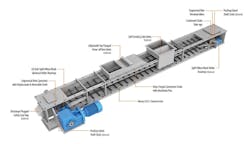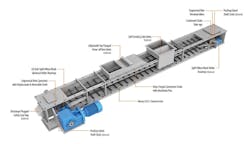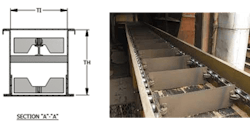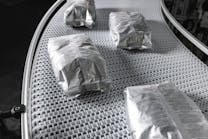Bulk solid materials are involved with 80% of manufactured or transported goods worldwide. However, the materials and their applications have many variations that require a range of different conveying options. To efficiently transfer free-flowing materials in a relatively straight line in a plant or trans-loading facility a drag conveyor can be an effective option.
Drag conveyor operation
A drag conveyor is a simple machine that drags or pushes bulk solid materials along a trough using paddles that are firmly attached to an endless loop of chain. Material enters from above at one end of the conveyor and is then dragged along the trough and discharged through a hole in the bottom of the chute at the opposite end. Multiple destinations can easily be achieved by opening or closing appropriate sections at the bottom of the trough. After the material discharges, the empty paddles and chain then travel in a loop back to the material pickup point.
Drag conveyors are extremely efficient because all the energy goes into moving material. This is unlike some other conveyors, such as pneumatic conveying, in which much of the energy is used to compress and move the conveying gas.
Drag conveyor layout and sizing
Drag conveyors are generally short to medium in length. Most are 20 to 200 feet long, but distances up to a few hundred feet are possible.
The capacity of a drag conveyor is a function of the paddle’s size and speed. In other words, a bigger paddle moving at a higher speed through a larger trough will push more material at a faster velocity. Volumetric throughput is equal to the cross-sectional area of the material in the trough multiplied by the linear speed multiplied by the slope factor. Gravimetric throughput is equal to the volumetric throughput multiplied by the bulk density of the material.
For optimal operation, it is important to not overfill the trough. The cross-sectional area of the material is typically 40% to 50% of the housing's cross-sectional area. The linear speed of most process conveyors is around 75 to 150 feet per minute. Drag conveyors for abrasive or heavy materials operate at slower speeds of 25 to 50 feet per minute to reduce abrasive wear.
Most drag conveyors are horizontal and do not include direction changes. Some allow a simple direction change, such as a horizontal section followed by an upward angle. Horizontal drag conveyors have the best conveying capacity. Upwardly sloped conveyors will have less conveying capacity if the slope exceeds 10 degrees or so. Above 10 degrees, specially shaped paddles are often required, along with slower speeds and less cross-sectional fill. As a result, angled units must be upsized, and it is common to use units that are 15% bigger for a 15-degree slope and 30% bigger for a 30-degree slope.
Drag conveyor advantages and disadvantages
Drage conveyors are simple, compact and efficient. Some drag conveyors are used for medium rates of a few tons per hour. However, higher rates are more common because their low energy usage is especially valuable at high rates, up to hundreds of tons per hour.
Drag conveyors are best suited for dry, free-flowing materials. They are inappropriate for sticky, cohesive materials that stick to the trough or paddles. They are not intended for very dusty or fine powders that will leak around the paddles. However, they can be effective with materials such as grain with big particles and some dust. And they readily handle high temperatures up to around 300 degrees Fahrenheit.
Abrasive wear will occur since the material is sliding along the trough. Therefore, more expensive wear-resistant construction is required when conveying abrasive materials.
Drag conveyors are not intended for hygienic service or if material cleanout or cross-contamination is a concern. The chain and paddle assemblies have many gaps and crevices, making cleaning impractical. A small heel of material generally remains in the housing.
Drag conveyors have moving parts such as chains, sprockets, drives, tensioners and bearings, all of which require maintenance. Because everything within the housing is exposed to the material, drag conveyors are usually not a good choice for corrosive materials.
Conclusion
Drag conveyors are a viable choice for moving free-flowing bulk solid materials. Their compact, simple design and excellent energy efficiency shine when conveying high rates in a straight line or slight incline. However, dust collection, wear and maintenance must be considered.





